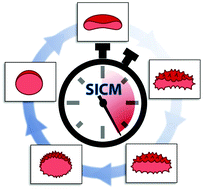Monitoring dynamic spiculation in red blood cells with scanning ion conductance microscopy†
Abstract
Phospholipids are critical structural components of the membrane of human erythrocytes and their asymmetric transbilayer distribution is essential for normal cell functions. Phospholipid asymmetry is maintained by transporters that shuttle phospholipids between the inner leaflet and the outer leaflet of the membrane bilayer. When an exogenous, short acyl chain, phosphatidylcholine (PC) or phosphatidylserine (PS) is incorporated into erythrocytes, a discocyte-to-echinocyte shape change is induced. PC treated cells remain echinocytic, while PS treated cells return to discocytes, and eventually stomatocytes, due to the action of an inwardly directed transporter. These morphological changes have been well studied by light microscopy and scanning electron microscopy in the past few decades. However, most of this research is based on the glutaraldehyde fixed cells, which limits the dynamic study in discrete time points instead of continuous single cell measurements. Scanning ion conductance microscopy (SICM) is a scanning probe technique which is ideal for live cell imaging due to high resolution, in situ and non-contact scanning. To better understand these phospholipid-induced morphological changes, SICM was used to scan the morphological change of human erythrocytes after the incorporation of exogenous dilauroylphosphatidylserine (DLPS) and the results revealed single cell dynamic morphological changes and the movement of spicules on the membrane surface.

- This article is part of the themed collection: Analyst Recent HOT articles


 Please wait while we load your content...
Please wait while we load your content...